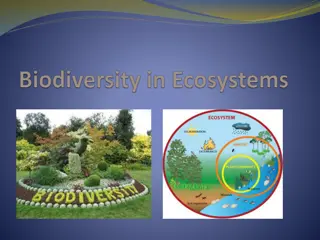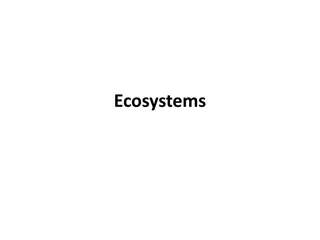Understanding Population Dynamics in Ecosystems
Exploring the concept of carrying capacity, examining real data from Mono Lake, comparing predictions to actual data, discussing biotic and abiotic limiting factors, and understanding how organisms can impact populations without direct predation. Dynamic ecosystems are constantly changing, as evidenced by the fluctuations in population sizes and abiotic conditions at Mono Lake throughout the year.
Download Presentation

Please find below an Image/Link to download the presentation.
The content on the website is provided AS IS for your information and personal use only. It may not be sold, licensed, or shared on other websites without obtaining consent from the author. Download presentation by click this link. If you encounter any issues during the download, it is possible that the publisher has removed the file from their server.
E N D
Presentation Transcript
Warm up Scan through the story Limiting Factors and look for the definition of carrying capacity. What is carrying capacity? The total number of individuals of a population that can be sustained indefinitely by an ecosystem.
Data From Mono Lake Up to now, we have been looking at theoretical population growth (reproductive potential) and laboratory data obtained from experiments conducted away from the natural ecosystem. Now we are going to look at some real data collected by ecologists at Mono Lake. Look at the two graphs on Abiotic Factors at Mono Lake Based on what you know about the populations of planktonic algae and brine shrimp, and the light and temperature conditions at Mono Lake, how big do you think the populations of those two organisms will be over the course of a year?
Compare Predictions to Data Look at the data on lab sheets 38 and 39. Light and temp graphs are on page 38. Population graphs for planktonicalgae, brine fly and brine shrimp are on page 39. Were your predictions accurate? How can we explain the drop in populations during the warmest part of the year? The algae must be dying, leaving or being removed from the population.
Biotic Factors Sometimes populations are limited by other organisms. These are called biotic limiting factors. Can you think of any biotic factors that might limit a population? Predator/prey. When one organism eats another, the population of those being eaten is reduced.
Other Ways Are there other ways that an organism can limit the population without eating them? What happens to the oak trees when squirrels gather acorns? Potential new trees are lost. What happens when a larger, more aggressive bird, pushes eggs of another bird out of a nest? Reproductive potential is lost. What happens to a population of clover when a cow eats it? Reproductive potential is reduced. What happens to fish when there is a disease caused by fungus? Affected fish may not be able to reproduce.
Dynamic Ecosystems Ecosystems are dynamic. That means they are always changing. The Mono Lake graph shows how some of the populations of organisms change and how the abiotic conditions change through out the year. Answer the questions on page 41 using information from the graphs to support your ideas. Use complete sentences and make sure you support your beliefs with DATA.
Abiotic Factors What abiotic factors did we look at in Mono Lake? Water temp and light How does temperature affect the populations in the lake? With the exception of planktonic algae, the populations increase as the water warms and decrease as it cools. What other abiotic factors could affect the populations in the lake? Water depth, salt concentration, wind, silt, nutrients, elevation.
Biotic Factors What biotic factors did you look at? Trophic (feeding) relationships Brine shrimp eat planktonicalgae. How does algae act as a biotic limiting factor on the population of brine shrimp? The brine shrimp population can grow only as long as there is algae to eat. If the algae becomes depleted, the brine shrimp population also decreases. How does brine shrimp act as a limiting factor on the algae population? The algae population decreases every time the brine shrimp eats. What causes the bird populations to increase and decrease so rapidly in the Mono Lake ecosystem? Migratory birds come and go.
Summary of Mono Lake Mono Lake is dynamic. The populations fluctuate dramatically during the year. During the cold of winter, Mono Lake looks like a wasteland. There are no birds, brine shrimp or brine flies. Due to this, the population of algae explodes. The algae can grow in the colder temps and there are no limits on it s growth. When spring arrives with warmer temps, brine flies and shrimp hatch and begin to eat the algae. The algae can not reproduce fast enough and the population declines.
Summary of Mono Lake As summer nears, the first birds begin to arrive. The birds eat the brine shrimp and begin to slow its population growth. The brine shrimp do not start to decline though, until summer when all the birds have arrived. This rapid decline is because their food supply is dwindling and they are being eaten. By October, the nutrients in the water have been depleted, the predation has taken its toll on the algae and its population falls to its lowest levels The cooling water causes the brine fly and shrimp eggs to go into dormancy and the population falls to zero.
Summary of Mono Lake When the surface water approaches freezing, it becomes so dense it sinks. When it reaches the bottom of the lake, it stirs up nutrients and those nutrients are now available for the algae. The algae once again begin to reproduce, turning the lake green once again for the process to start all over.
Limiting Factors A healthy population has limits set on it. Growth seems like a good indicator of health. However, populations all have the potential to grow way beyond the ability of the environment to support it. Therefore, a healthy population depends on limiting factors. Example: The brine shrimp rely on the birds to keep their numbers in check so they don t exhaust or damage the algae food source. A healthy ecosystem is flexible and durable. Carrying capacity is the maximum size a population can reach in a ecosystem. https://www.youtube.com/watch?v=QI2ixJeIxEU Begin Reading Limiting Factors pages 22-24, if time.























